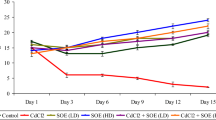Abstract
Curry leaves are one of the spices used in Indian dishes for aroma and preservation. There are no reports on the antioxidant properties of curry leaves. In this study, the antioxidant potential of curry leaves in rats treated with a known chemical carcinogen, dimethylhydrazine hydrochloride (DMH) was investigated. Food intake was reduced in the rats fed curry leaf-supplemented diet but the body and the organ weights were not affected.Vitamin A content in the liver was significantly increased whereas glutathione (GSH) content was not altered. A 50% reduction was seen in the micronuclei induced by DMH and a 30% reduction in the activity of γ,-glutamyl transpeptidase when the rats were fed a curry leaf-supplemented diet. These results indicate that curry leaves have highpotential as reducer of the toxicity of DMH.
Similar content being viewed by others
References
Iyer UM, Mani UV (1990) Studies on the effect of curry leaves supplementation on lipid profile, glycated proteins and amino acids in non insulin dependent diabetic patients. Plant Food Hum Nutr 40: 275–282.
TheWealth of India. Publisher Council of Scientific and Industrial Research, New Delhi1962, pp 446–447.
Nadkarni AK (ed) (1976) Indian Materia Medica, Vol 1. Popular Prakashan Pvt. Ltd.
Khan BA, Abraham A, Leelamma S (1996) Biochemical response in rats to in addition of curry leaf (Murraya Koenigii) and mustard seeds (Brassica juncea) to the diet. Plant Food Hum Nutr 49: 295–299.
Girotti AW, Deziel M (1983) Photodynamic action of protoporphyrin on resealed erythrocyte membranes: Mechanism of trapped markers. In: Kessel D, Doughenty TJ (eds), Prophyrin Photo Sensitization. New York, Plenum Press, pp 213–225.
Ellman GL (1958) Liver glutathione. A colorimetric method for determining low concentrations of mercaptans. Arch Biochem Biophys 74: 443–450.
Dann WJ, Evelyn (1938) The determination of Vitamin A with the photoelectric colorimeter. Biochem J 32: 1008–1017.
Cohen G, Dembiec C, Marens J (1970) Measurement of catalase activity in tissue extracts. Anal Biochem 34: 30–38.
Weiss C, Maker HS, Lehrer GM (1980) Sensitive fluorometric assays for glutathione peroxidase and reductase. Anal Biochem 106: 512–516.
Habig WB, Pabst MJ, Jokoby WB (1974) Glutathione S-transferases. J Biochem 249:7130–7139.
Meister A, Tate SS, Griffith OW (1981)-Glutamyl transpeptidase. Meth Enzymol 77:237–253.
Countryman PI, Heddle JA (1976) The production of micronuclei from chromosome aberrations in irradiated cultures of human lymphocytes. Mutat Res 41: 321–332.
Asp NG, Johnson CG, Halimer H, Siljestrom M (1983) Rapid enzymatic assay of insoluble and soluble dietary fiber. J Agric Food Chem 31: 476–482.
Arya SS, Nateshan V, Parihar DB, Vijayraghavan PK (1979) Stability of carotenoids in dehydrated carrots. J Food Technol 14: 579–586.
WHO (1990) International Programme on Chemical Safety Environmental Health Criteria 109, WHO.
Kummet T, Meysten FL Jr (1983) Vitamin A: A potential inhibitor of human cancer. Semin Oncol 10: 281–289.
Schwartz J, Suda D, Light G (1986). Beta carotene is associated with the regression of hamster buccal pouch carcinoma and the induction of tumor necrosis factor in macrophages. Biochem Biophys Res Commun 136: 1130–1135.
Linder MC (1985) Nutrition and cancer prevention. In: Linder Mc (ed), Nutritional Biochemistry andMetabolism with Chemical Applications. New York: Elsevier, pp 347–368
Fiala S, Mohindra A, Kettering WG, Fiala AE, Morris HP (1976) Glutathione and gamma glutamyl transpeptidase in rat liver during chemical carcinogenesis. J Natl Cancer Inst 57: 591–598.
Author information
Authors and Affiliations
Rights and permissions
About this article
Cite this article
Khanum, F., Anilakumar, K., Sudarshana Krishna, K. et al. Anticarcinogenic effects of curry leaves in dimethylhydrazine-treated rats. Plant Foods Hum Nutr 55, 347–355 (2000). https://doi.org/10.1023/A:1008148531495
Issue Date:
DOI: https://doi.org/10.1023/A:1008148531495




